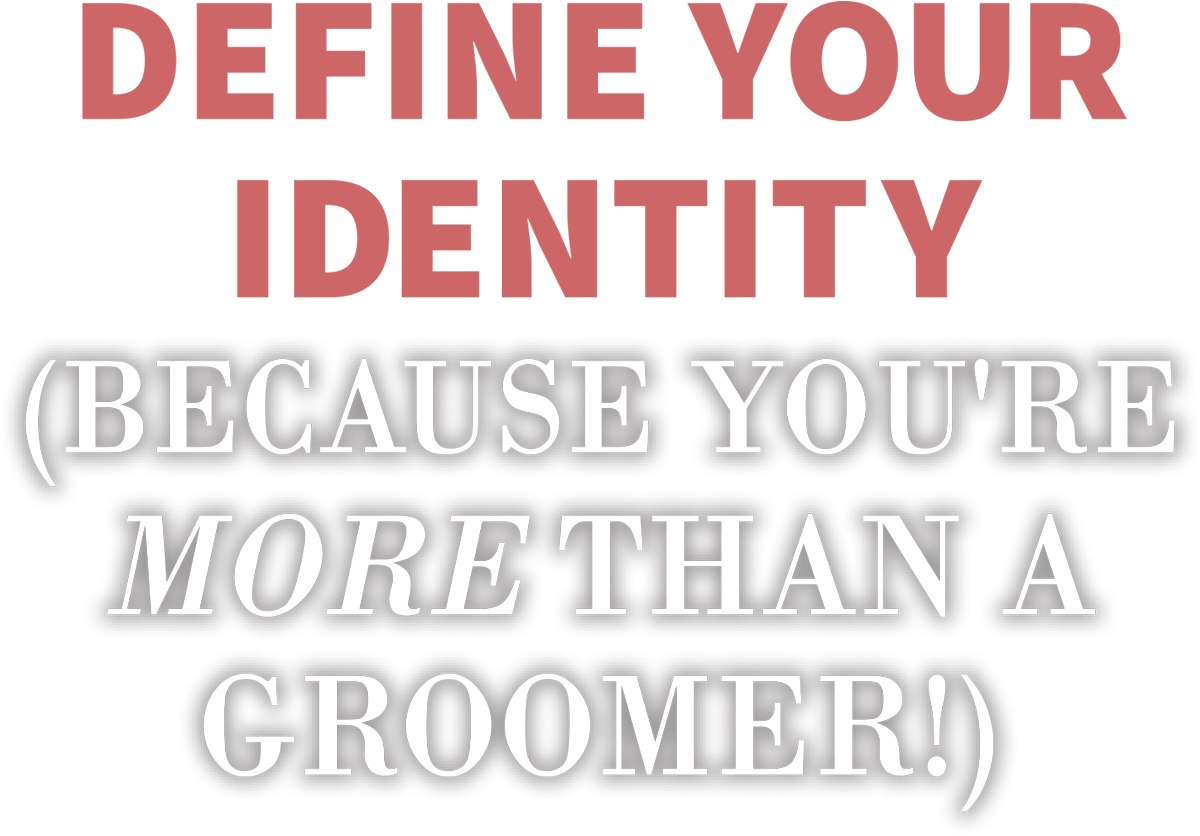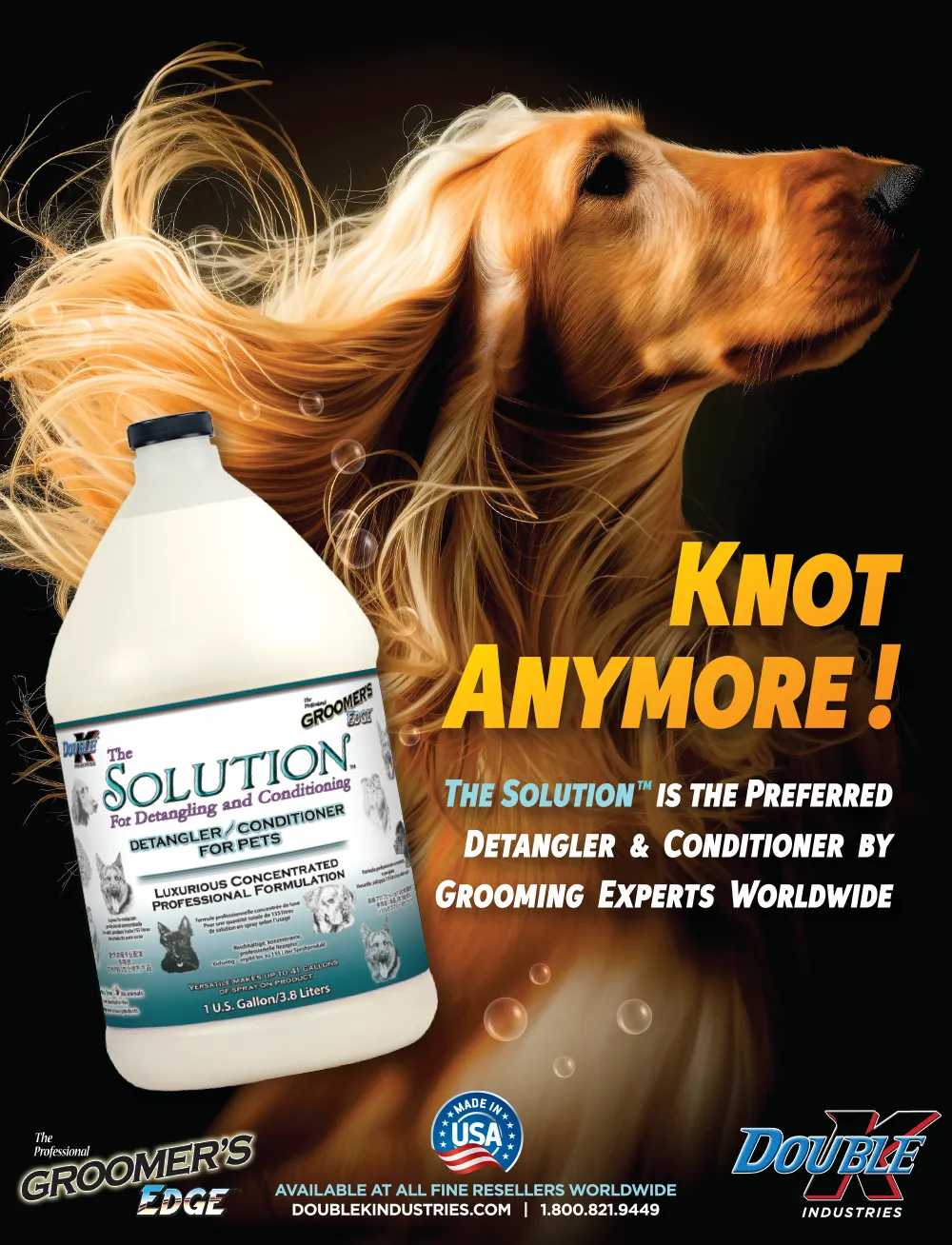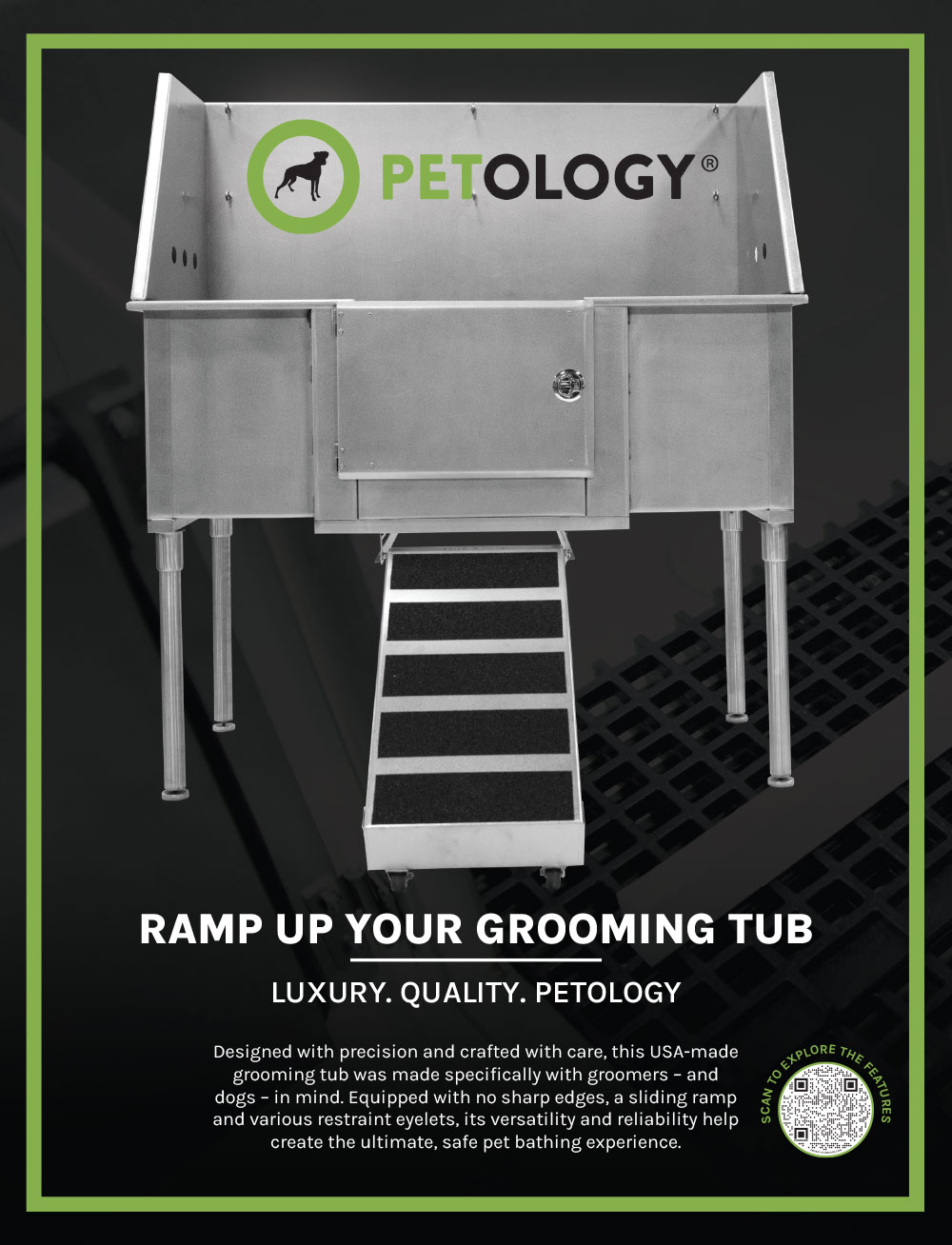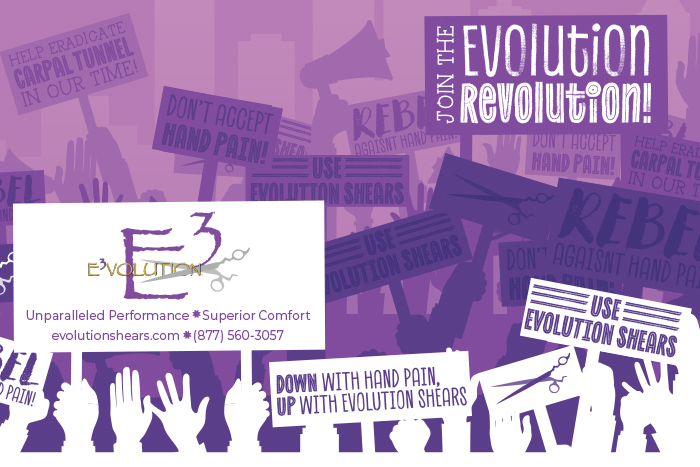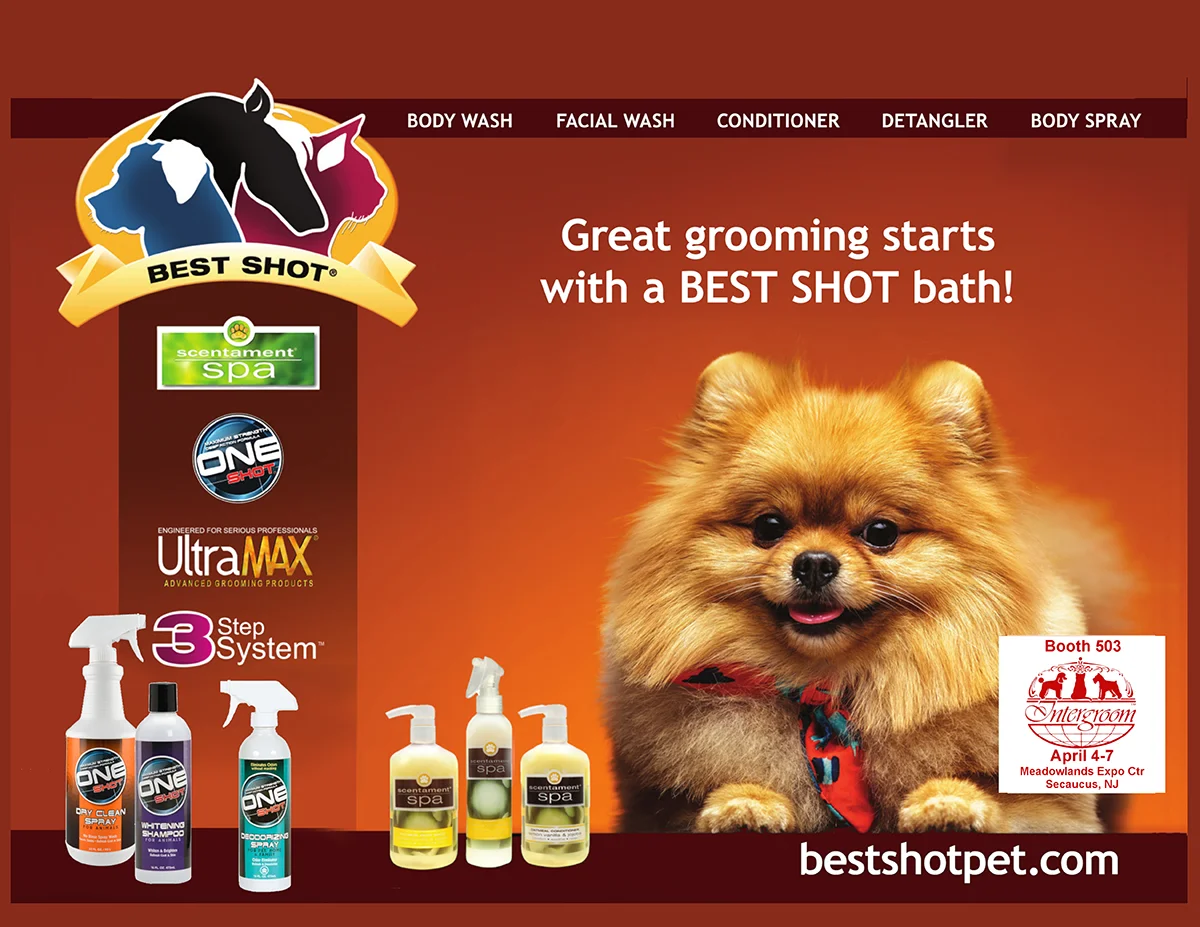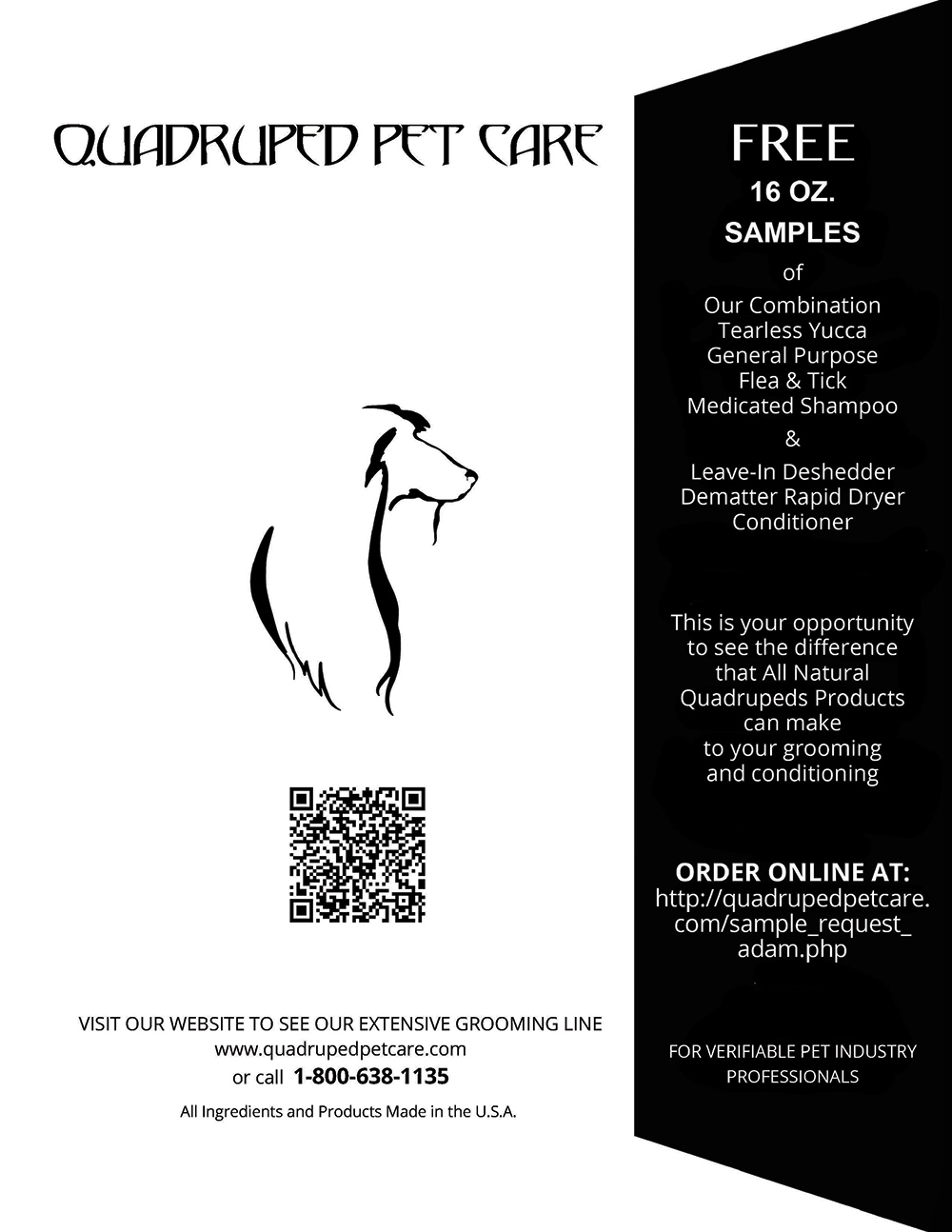Contents | April 2024
26
by Kathy Hosler
34
by Kim Kier
ALSO INSIDE
todd@barkleigh.com
adam@barkleigh.com
gwen@barkleigh.com
rebecca@barkleigh.com
luke@barkleigh.com
laura@barkleigh.com
brandi@barkleigh.com
carlee@barkleigh.com
evan@barkleigh.com
cassidy@barkleigh.com
allison@barkleigh.com
james@barkleigh.com
karin@barkleigh.com
britany@barkleigh.com
Daryl Conner
Jonathan David
Dr. Cliff Faver
Blake Hernandez
ALSO INSIDE
ON THE COVER

it’s advertisers for their continued support.
- Andis2
- Animal Photography18
- Animals Ink23
- Bandanas Unlimited44
- Barkleigh Store Catalog62
- Barkleigh Store Groom-o-Gram15
- Best Shot – Scentament Spa19
- Best Shot – Scentament Spa25
- BioOx60
- Cool Dog Wash Tubs23
- Cosmos Bathing Systems56
- Direct Animal Products9
- Double K Industries3
- Electric Cleaner Company22
- Envirogroom | Special FX53
- Evolution Shears12
- Groomer’s Best58
- Groomers Mart48
- Groomore7
- Happy Hoodie13
- Iv San Bernard | Pet Skin Academy40
- Jodi Murphy39
- Laube61
- MetroVac14
- Paragon16
- Pet Biz Insurance41
- Pet Boarding Expo West29
- PetLift43
- Petology4
- Puppy Play Ground21
- Pure Pet27
- Quadruped Pet Care37
- Ryan’s Pet Supplies64
- Ryan’s Pet SuppliesDigital Only
- Stallergenes Greer33
- Stazko17
- Stone Mountain Pet Products24
- The Absorber Dog Lover’s Towel11
- Thera-Clean57
- Tool Klean10
- Tool Klean47
- Wag’n Tails49


 t is easy to fall into the trap of allowing your work to define you. After all, you spend so much time, money and energy to ensure its success. What starts as a clear division of you from your business becomes a fine line, and before you know it, there is no line, and your business has your identity wrapped around its fingers. And now, the typical day-to-day obstacles of running a business—such as stagnant sales, poor reviews, questioned protocols and so forth—become personal attacks rather than the opportunity to review how your company operates.
t is easy to fall into the trap of allowing your work to define you. After all, you spend so much time, money and energy to ensure its success. What starts as a clear division of you from your business becomes a fine line, and before you know it, there is no line, and your business has your identity wrapped around its fingers. And now, the typical day-to-day obstacles of running a business—such as stagnant sales, poor reviews, questioned protocols and so forth—become personal attacks rather than the opportunity to review how your company operates.
We all know the importance of setting good boundaries with our clients, but the most significant boundary that should have been set—the one between you and your business—is taken for granted. Like a bad client, our business begins to walk all over us. We start making decisions without the opportunity to review them because it isn’t just that the company is wrong, it’s your reputation that’s on the line.
This lack of separation is not something that happens overnight; it’s gradual. You only notice once you’re posting angry responses to reviews and to other groomers who talk about different methods utilized in their businesses. So how do you know if you, too, have blurred the line between you and your business?
To start, ask yourself these eight questions:

- How much time do you spend thinking about work at the end of your day? If your response is, “What end of day?” then there is no separation, and you’re probably overworked, over-managed and burnt out.
- How do you describe yourself? Can you do it without using the words business owner or groomer? Your occupation is not who you are. This one is tough, but it should be easy. We’re so used to being defined by our roles that we forget we’re people.
- How much time off do you have in a 168-hour week? Be honest with yourself. Where are you in that 40-168 range? When was the last time you took a vacation? Overworking and never taking a vacation is not a badge of honor. You don’t have to go anywhere or spend money; just don’t work.
- How much work are you doing in your business because only you can do it right? Think about hiring out for different aspects of your business if you can afford to.
- What do you do for fun (unrelated to work)? Do you have any hobbies?
- How would you feel if you had to choose a different profession tomorrow?
- How often do you go to social media for a rebuttal or to tear down what someone else is doing?
- Do you feel excited or exhausted when you think of your business?


- Set a beginning and end to your day. If your day ends at 5:00, leave at 5:00 and don’t accept or return calls to clients until the following day during your designated work hours.
- Take a vacation. Close down your business for a week. If you can’t shut down because you planned on income coming in 52 weeks a year rather than 50, it’s time to sit down with a business coach or accountant and rework your pricing.
- Know when to delegate and hire out. Need help figuring out where to start? Get a business coach.
- Rework your processes so you are more efficient. Again, if you need help figuring out where to start, get a coach.


 ou’ve probably heard older groomers express regret that they did not do more when they were young to take care of their hands. You may have seen some of us with swollen joints and bent fingers, or others wearing compression gloves, splints or other mechanical aids, and even some with surgical scars.
ou’ve probably heard older groomers express regret that they did not do more when they were young to take care of their hands. You may have seen some of us with swollen joints and bent fingers, or others wearing compression gloves, splints or other mechanical aids, and even some with surgical scars.
As groomers, we make our living with our hands. They are our most important tools and our most precious asset. Now that I am well into my 60s, after 45 years of part- and full-time grooming, the pain in my arthritic hands is pretty much constant throughout the day and night. I have a specialized hand doctor, general weakness in both hands, have had multiple surgeries and injections, use braces or compression aids, get regular massages, and must employ other strategies that are a constant, and expensive, part of my life now.

Since rheumatoid arthritis can be inherited, is more serious and medically caused, it is not usually linked to work-related stress or injury. Osteoarthritis is what groomers commonly struggle with as they age. Osteoarthritis is caused by physical activity, stress, repetition, working conditions and other matters over which we have more control, such as our diet.
In a recent poll of those over 50 in the United States, over 60% reported having arthritis that limits their activities, 30% reported being diagnosed with osteoarthritis from wear and tear on their joints, and 70% reported being in pain from it.2 Osteoarthritis is described as a degenerative joint disease by other medical experts and is more likely to occur as a person gets older.
Dr. Wayne McCormick, a geriatrician at the University Of Washington School Of Medicine says, “It’s basically just worn-out joints. Osteoarthritis is most commonly seen among people over 50, particularly women.”3

Cleveland Clinic tells us, “There are hereditary forms of osteoarthritis that are caused by mutations in genes for collagen. This type of osteoarthritis can first appear at a young age, quickly causing severe damage, though not very common. Around 40 to 65% of osteoarthritis has a genetic component, with a stronger link for hand and hip cases. The influence of other factors, such as obesity, joint injuries, aging and joint anatomy, also is quite substantial.”4
Bone spurs are another aspect of osteoarthritis that many of us now experience, which one article describes as, “… when [cartilage] starts to break down, the bones of the finger joints become irritated and inflamed due to increased friction. When this occurs, the body creates new bone as it tries to repair itself, resulting in an overgrowth of bone (bone spur) in the joint spaces of the fingers … Bone spurs may also occur when the body tries to heal itself after an injury or due to repetitive overuse … Activities that cause repetitive joint use and stress in the hands can cause cartilage between the joints of the fingers to break down, causing damage that leads to bone spurs.”5
Hand surgery can sometimes be required if the bone spurs break away inside the fingers and need to be removed. Care for bone spurs includes rest, immobilization with splints, ice, physical therapy with a hand specialist, over the counter NSAIDs and corticosteroid injections directly into the joints, which is something else I have benefitted from.
- Avoid eating processed foods.
- Don’t dwell on your pain, but do track it each day, perhaps recording with a number to indicate the level of discomfort.
- Do not wear uncomfortable or poor-quality shoes.
- Pace yourself and take breaks.
- Get your family and friends involved with your arthritis awareness.
In a Psychology Today article that asks why young people seem to feel immortal, Dr. Gary Wenk explains that it takes well into our 20s and 30s for our brains to fully develop and enable us to anticipate the consequences of our actions. He says, “When your frontal lobes finally complete their process of myelination, they begin to work properly, and you stop doing dangerous things. Most importantly, you stop feeling immortal.”7
Sadly, by the time many of us pet groomers are in our later 20s and 30s, we have already established patterns and habits, including how we groom, that are not good for our bodies in the long term.
Food choices can also help. One source outlines the follow six foods/food groups as being the most beneficial in reducing joint pain and inflammation:8
The sooner we start thinking about the span of our lives that lies ahead of us and realize that what we do to our bodies now will have significant consequences in our most productive and important years, our 40s and beyond, the longer and more productive our careers—and lives—will be.
- Arthritis. Mayo Clinic. https://www.mayoclinic.org/diseases-conditions/arthritis/symptoms-causes/syc-20350772
- Arthritis and Joint Pain. (2022, Sept). University of Michigan. https://www.healthyagingpoll.org/reports-more/report/arthritis-and-joint-pain
- Is Arthritis Avoidable? (2023). New York Times. https://www.nytimes.com/2023/04/18/well/live/arthritis-prevention-symptoms.html
- Is Arthritis Hereditary? (2019, June). Cleveland Clinic. https://health.clevelandclinic.org/is-arthritis-hereditary
- What Causes Bone Spurs in the Hand? (2023, Sept). Very Well Health. https://www.verywellhealth.com/bone-spurs-in-hand-5095905
- 5 Bad Habits to Drop for Better Arthritis Management. (2021, Jan). Arthritis Today Magazine. https://blog.arthritis.org/living-with-arthritis/bad-habits-arthritis-tips/
- Why Do Teenagers Feel Immortal? (2010, Aug). Psychology Today. https://www.psychologytoday.com/us/blog/your-brain-food/201008/why-do-teenagers-feel-immortal
- 6 Foods That May Help Your Arthritis. (2023, April). Arthritis Foundation. https://www.arthritis.org/health-wellness/healthy-living/nutrition/healthy-eating/six-foods-for-arthritis

Photos provided by Tracy Jervis
 y phone is always ringing. My biggest problem right now is finding a place on my schedule to put the dogs,” says central-Virginia-based groomer Tracy Jervis.
y phone is always ringing. My biggest problem right now is finding a place on my schedule to put the dogs,” says central-Virginia-based groomer Tracy Jervis.
After years spent as a homemaker and now in her 50s, the new groomer took a leap of faith in opening a mobile grooming business in 2020 during the COVID-19 pandemic, but luckily it’s paid off financially and emotionally.
However, the seed to pursue dog grooming was planted decades before when Tracy bred Maltese. “I’d take them to PetSmart for grooming and would see 20 dogs coming in, plus 20 going out,” she shares. “I started doing the math, and I could see the potential of making a good income doing something I didn’t mind doing. I was thinking about being a cosmetologist, but thought dog grooming would be awesome, too.”
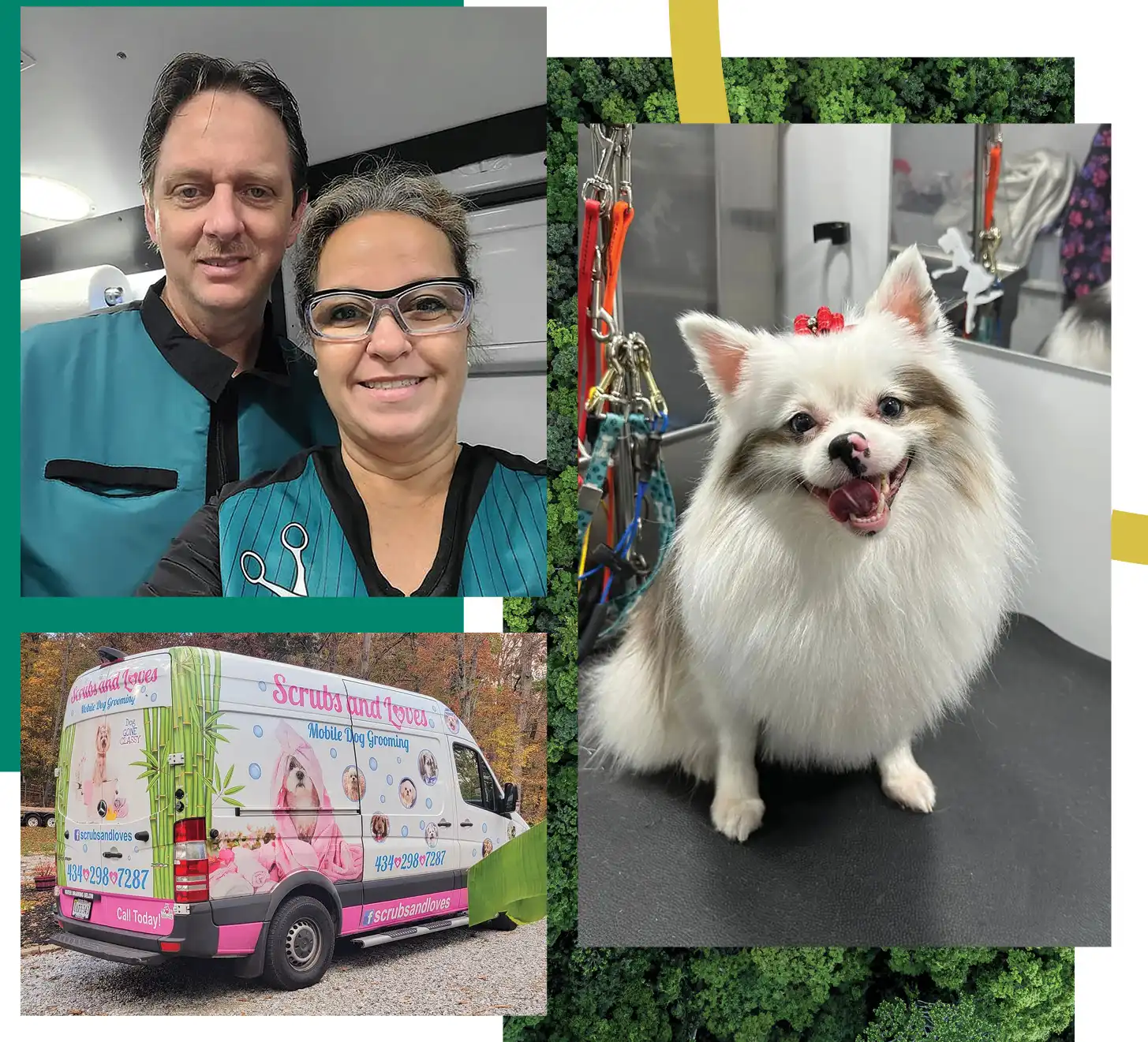
As a dedicated domestic engineer, Tracy knew she wanted a career when her children grew older. To prepare, she attended cosmetology classes at the local community college. “I worked for a while at Wal-Mart cutting hair during my internship program,” she shares. “I felt nervous all the time, and it was hard to enjoy working in public and being responsible for how the person would look or react.”
Eventually, Tracy quit because she wasn’t comfortable. Then, she attended dental assistant school and worked as a dental assistant and office clerk in two separate locations for nearly three years. But when the pandemic hit, Tracy found herself laid off from the dentist’s office.

“Right away, I took the video and showed him,” Tracy explains. “To my surprise, he said, ‘Well, if this is what you want to do, then we better go all out! Go find what you want to do—shop or mobile.’”
Tracy discovered mobile groomer Jessica Adorno’s Facebook page and says, “Jessica continues to inspire me and is available for Q&A. I went to the Hanvey site and KNEW this was it! It was a huge step for us, as I had no formal experience in dog grooming other than my little home hobby of breeding and grooming. It was risky.”
Knowing she needed more than just a van to build her business, Tracy went to work on acquiring everything else she needed: “I used my unemployment money to buy all my grooming shears, clippers, blades, etc., and saved some for my decals on the van,” she shares. “But most importantly, I used some of the money for my online grooming class to get my certificate from onlinedoggrooming.com.”
However, an online grooming school doesn’t offer hands-on grooming, so Tracy found other programs to join, too, such as Learntogroomdogs.com, Paragon School of Grooming and Groom Haüs.
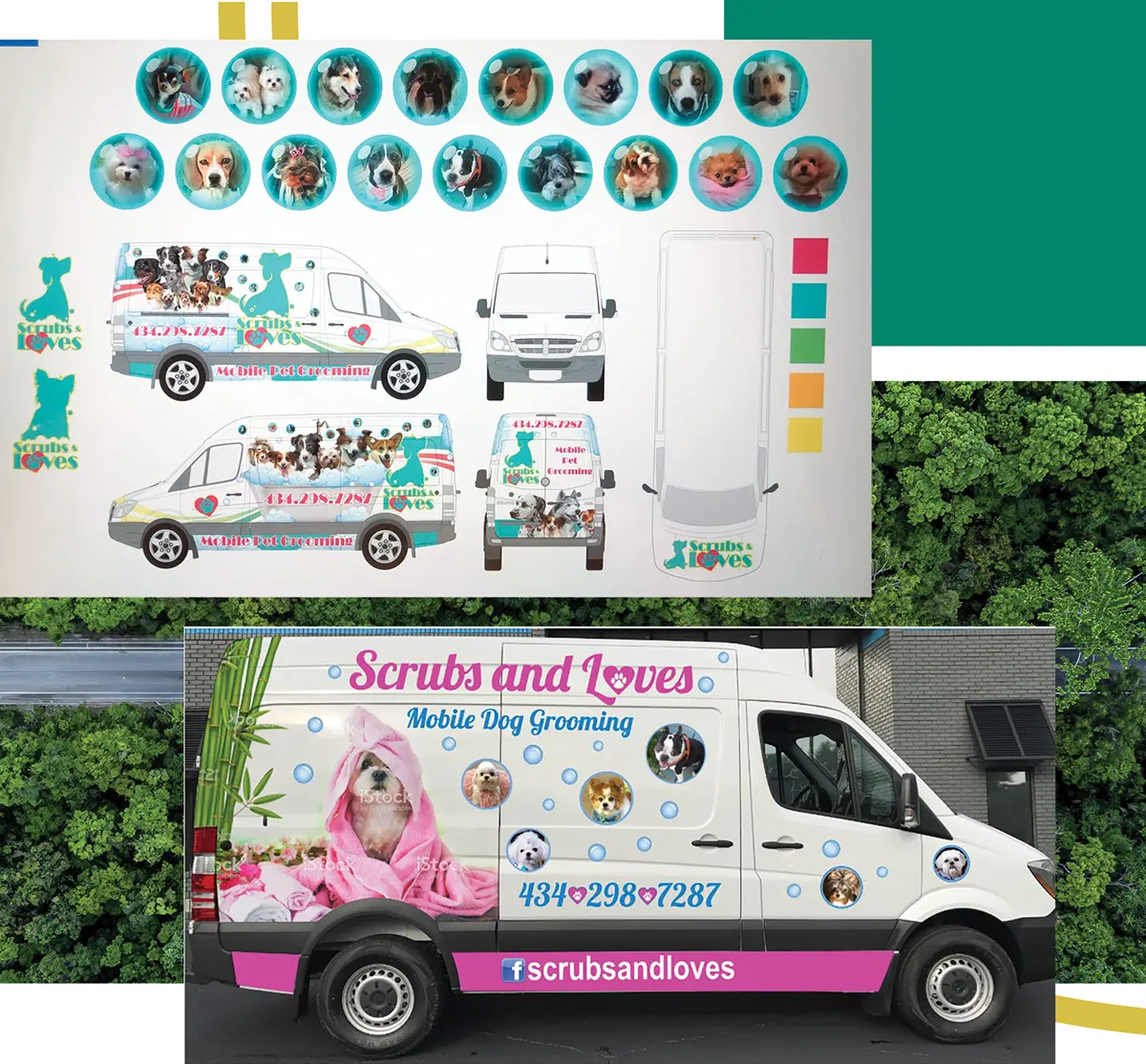
“I worked for several weeks grooming all sorts of dogs,” Tracy continues. “At the end of my course, I sent in three pictures and aced my test! I was happy to print off my certificate and happily display it in my van today.”
In August 2020, Tracy officially opened Scrubs and Loves for business. “I couldn’t believe I was finally grooming and owning my own business,” she shares. “I was really doing it, and it felt great! It came so easily to me. I absolutely get an inside rush of pride every time someone says to their dog how beautiful they look. It’s a good feeling, and I’m so blessed to have this wonderful career.”
Since then, Tracy continues to learn from different groomers and websites. Of course, some techniques are more difficult to master.” Tracy says, “I struggle with Asian fusion-style grooms and Poodle feet, and I struggle to get both sides of any dog’s face the same.”
“Sure, it took some time to learn how to hold it just right,” Tracy continues. “And not all dogs want to give me a minute to hold it there, but it worked. So glad I discovered it! I can use it around feet, too.”
Eager to immerse themselves even further into the grooming industry, Tracy and Willie attended their first Groom Expo in 2022. “I will never forget that day,” Tracy shares. “We walked in, and both our jaws dropped. It was absolutely fantastic. The lights, the music, the people, and all the products. It was like walking into a secret world of dog grooming—a members-only type thing. I’ve never felt so proud to be part of something so grand.”
With business booming and the money coming in, Tracy is working towards finding the right balance of the “perfect-fit” dogs. “I have been grooming nonstop since I started,” she shares. “If I allowed it, this business would have me 24-7, so eventually, I would like to slow down and do just a few dogs a day—weeding out any dog that makes me stressed or feel uncomfortable. This opens the way to take on other dogs that would be a good fit for me.”

To conclude, Tracy says, “Each person needs to explore their own value and priorities. If you believe it, then you can achieve it. I know it’s hard to do it if no one is backing you up—and you can’t do it alone—but if there is a strong will for it, then there will be a way.”

by Kathy Hosler
 know a stylist named Jenny who has been grooming for eight years. Four years ago, she opened her own salon where she put in many long hours and went above and beyond to attract and retain clients. She came in early, stayed late and often gave up her days off to accommodate her growing clientele. She did her best to please each client—often de-matting pets other salons had refused. Now, four years later, Jenny is successful…or is she?
know a stylist named Jenny who has been grooming for eight years. Four years ago, she opened her own salon where she put in many long hours and went above and beyond to attract and retain clients. She came in early, stayed late and often gave up her days off to accommodate her growing clientele. She did her best to please each client—often de-matting pets other salons had refused. Now, four years later, Jenny is successful…or is she?
Jenny still works long days. She doesn’t even stop for a lunch break, instead she depends on coffee and energy drinks to get her through the day. All the clients she accommodated by working extended hours when she first opened expect that to continue, and for Jenny to be at their beck and call. She tries to get her clients to pre-book their next appointment, but few do. Instead, they call Jenny when their pet is overdue for a groom and expect her to get them in immediately. And, if they neglect to brush their pet at home, they demand that she de-mat it. After all, she did it for them before.
Jenny is struggling. She is overworked, has no time for herself and is often bullied by clients who have little or no respect for her. This is not at all what she envisioned when she opened her salon. Jenny is exhausted and miserable. She feels helpless and thinks that her situation is hopeless. And, although she never told anyone, she is depressed and wonders if she can go on. Unfortunately, Jenny is not alone. Many groomers are struggling.

“I think that groomer self-care is one of the most important things we should talk about in the grooming industry. Your physical and mental health has everything to do with how you groom.“
– Jay Batista

“I think that groomer self-care is one of the most important things we should talk about in the grooming industry. Your physical and mental health has everything to do with how you groom,” Jay states. “I talk with many groomers, and it’s pretty evident that there is a lot of anxiety, depression, and eating disorders in our industry—and it’s definitely increased since COVID.
So, I asked Jay to share some of his thoughts and suggestions about the things that groomers can do and why they need to make themselves a priority. Here is what he had to say…
“Number one—don’t quit,” Jay says emphatically. “Almost everyone is struggling with something. So many groomers are stuck doing the same thing day after day. They don’t eat well, sleep well, they have no real goals, and often turn to alcohol and other things to keep going. Love and be kind to yourself. That’s hard for a lot of people who are trying to build a business or are supporting a family. They often put their own needs last. But, you need to love and take care of yourself in order to be able to care for others.
“Make improving your health a priority,” he continues “At work, stay hydrated and eat foods that will nourish and fuel your body. Don’t starve all day long, then go home and eat everything in sight, and then go to bed. Instead, take a lunch break, even if it’s just for a few minutes. Eat something healthy. It will give you energy to continue your work day.

– Jay Batista

“Take breaks throughout the day, even if it’s just five minutes. You can’t perform your best when you work nonstop. Take a short walk to get some sunshine and fresh air. It will clear your mind, refresh you, and give you a brief break from grooming. Getting adequate rest is also crucial. You are not a machine that can operate 24/7. Your body needs down time to rest and restore itself.
“Invest in yourself. That’s a big one,” Jay adds. “Never stop learning. Go to shows and take hands-on seminars. Take private lessons, sign up for online seminars, join online groomer groups. Ask questions and learn everything you can from others. It will help you boost your confidence and your skills.
“Set goals for yourself,” he continues. “When you see an opportunity, take it. Don’t be afraid to try new things. Find what you’re good at, then work till you master it. You will never regret improving your skills and increasing your knowledge.”
In conclusion, Jay says, “One of the best ways to help yourself is to help others. Be kind and encouraging to other groomers. Network and build relationships with them. Life is not easy for anyone. Any act of kindness you do for someone may change that person’s life. And, if you are struggling with any mental health issue, never be afraid to reach for help.”
At www.988lifeline.org you can call, text, or chat 24/7 at no cost to you.
The Spanish language lifeline is 1-888-628-9454.
If you speak a language other than English or Spanish, call 988 and you can be connected to a translator.
Deaf or hard of hearing can reach Lifeline via TTY by dialing 1-800-799-4889.











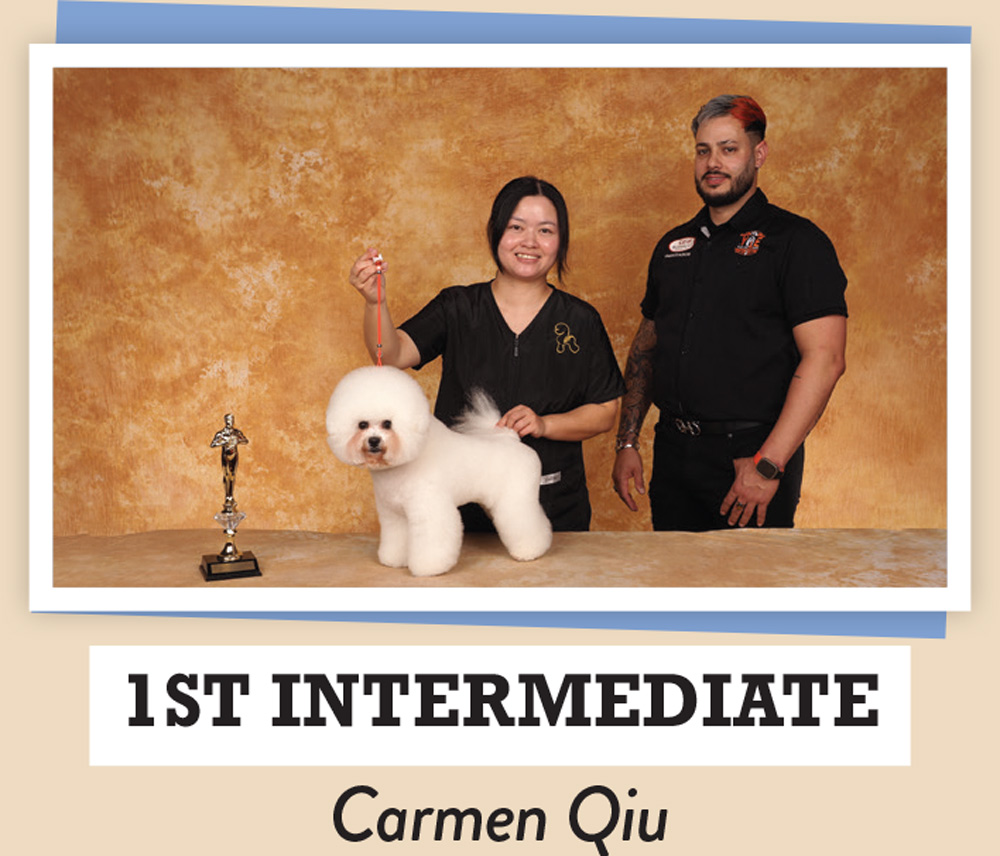


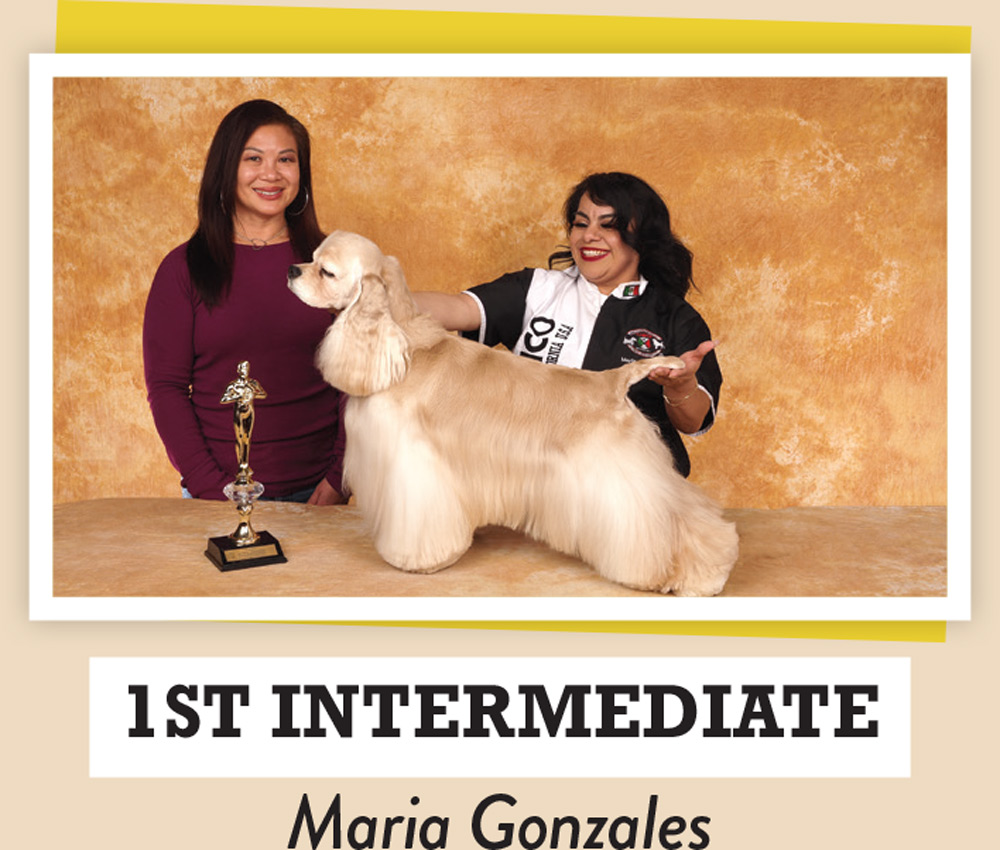


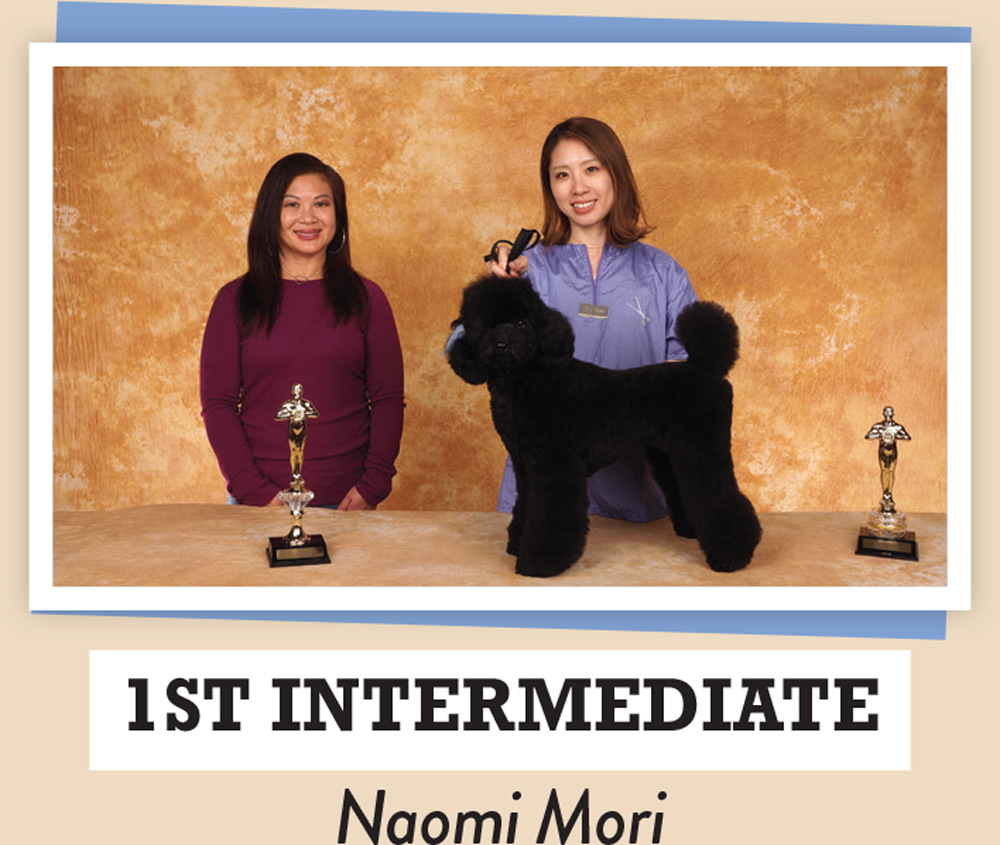
















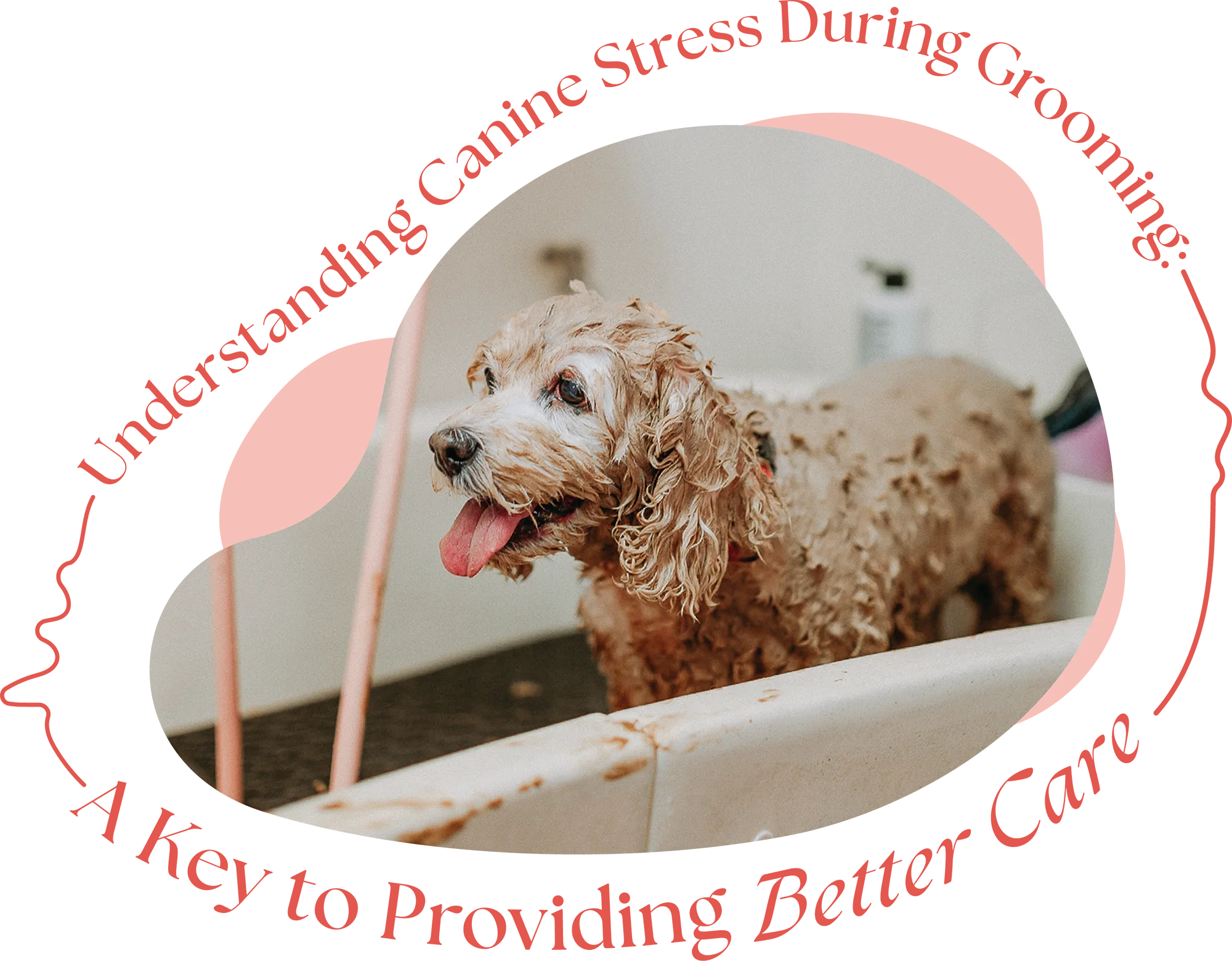
Photos provided by Little Barks Boutique
 n our line of work, we’ve all encountered dogs on our grooming tables who appear uncomfortable, are panting excessively or trying to escape—all clear signs of stress. We instinctively recognize these signals, but have you ever wondered what truly goes on in a dog’s mind during a grooming session?
n our line of work, we’ve all encountered dogs on our grooming tables who appear uncomfortable, are panting excessively or trying to escape—all clear signs of stress. We instinctively recognize these signals, but have you ever wondered what truly goes on in a dog’s mind during a grooming session?
In a 2022 case study published in the Brazilian Journal of Animal Science, researchers set out to investigate stress levels in dogs during their grooming experiences at a salon.1 The study involved a total of 55 grooming sessions, spanning from the moment the dogs were transported to the salon until they returned home.
The study encompassed evaluations of behavioral, physiological and blood components at various stages of the grooming process. The findings revealed that changes in dogs’ behavior and physiological parameters were most noticeable upon arrival and during the drying phase. Intriguingly, the characteristics of the groomers themselves also had an impact on the dogs’ behavior.
While grooming may seem like a straightforward process, it plays a vital role in a dog’s health and hygiene. Dogs undergo stressful situations during grooming, including interactions with unfamiliar people, contact with other dogs and exposure to a range of environmental factors. Though there is limited scientific research on this topic, studying how dogs behave during grooming can help us enhance the care we provide to our furry clients.
 Postural Responses: Dogs displayed reluctance and attempts to escape from stimuli. Their heads were often lowered compared to their shoulders, tails were held low, and ears were lowered with tails tucked between their legs.
Postural Responses: Dogs displayed reluctance and attempts to escape from stimuli. Their heads were often lowered compared to their shoulders, tails were held low, and ears were lowered with tails tucked between their legs. Calming Signals: Dogs exhibited calming signals such as raising a paw, lifting a front paw, licking their nose, yawning, looking away, turning their heads, and vocalizing.
Calming Signals: Dogs exhibited calming signals such as raising a paw, lifting a front paw, licking their nose, yawning, looking away, turning their heads, and vocalizing. Physiological Behaviors: Panting, rapid open-mouth breathing, shivering, and shaking were observed.
Physiological Behaviors: Panting, rapid open-mouth breathing, shivering, and shaking were observed. Behaviors Caused by Handling: Some dogs tried to escape, slipped, or changed positions.
Behaviors Caused by Handling: Some dogs tried to escape, slipped, or changed positions.Groomer’s Impact


Some dogs slipped during attempts to escape from bathing and drying, as they were not accustomed to the handling and the noises associated with it.
Escape Behavior
Kindness, empathy and attention to detail matter profoundly. Dogs are cherished members of families who trust us to provide the best care. As professional groomers, it is our responsibility to be their voice, to listen, observe and prioritize their needs.
By investing in training, knowledge and practicing kindness, we can make a positive impact on the lives of the dogs we groom. Let’s continue to put the welfare of dogs at the forefront of our work, ensuring they remain comfortable, safe, happy and healthy in our salons.
- Ferreira, M.; Rodriguez, M. A. P.; Oliveira, L. L. S.; Maranhão, C. M. A.; Oliveira, N. J. F.; Carvalho, C. C. S.; Afonso, M.V. R. and Madureira, M. R. 2022. Stress in dogs during grooming in a pet shop. Revista Brasileira de Zootecnia 51:e20200154. https://doi.org/10.37496/rbz5120200154
Kim Kier is the owner/groomer of Little Barks Grooming & Boutique, an award-winning luxury Salon in Columbia, South Carolina. She is also a Master Pet Aesthetician, Professional Grooming Credential (World Pet Association), Master Groomer Behavior Specialist, Fear Free Certified Professional, Low Stress Handling Certified Level Silver Certified, and Certified Puppy Consultant. Kim has recently been honored to be named “Grooming Guru” by Pet Product News International for 2023, and is the author of “Groomers Business Journal.”

 hat’s your purpose when you open your eyes in the morning? Do you have a routine you follow or is your day chaotic from beginning to end? Life gets chaotic on its own, so to avoid drowning in uncertainty, give yourself permission to dream of, plan and build a life where success is something obtainable.
hat’s your purpose when you open your eyes in the morning? Do you have a routine you follow or is your day chaotic from beginning to end? Life gets chaotic on its own, so to avoid drowning in uncertainty, give yourself permission to dream of, plan and build a life where success is something obtainable.
Being a successful pet groomer can mean many things to different people. Mostly it means accomplishing the goals you set for yourself. But before we can scratch that goal off our list, we first have to adjust the habits and behaviors that shape our ability to stay motived and achieve those goals.
They say that the most successful people have mastered the art of implementing and utilizing good habits. But what are “good habits” and how do we even begin to decode our habits, good and bad?
When we can commit to a set of habits, good or bad, it frees up our brain to make other decisions. This form of self-automation is considered a habit. Merriam-Webster defines the word “habit” as: a settled tendency or usual manner of behavior: an acquired mode of behavior that has become nearly or completely involuntary.
We all have habits that do not serve our greater good. We developed them over time and began to rely on them, even if they did not produce the results we wanted. The million-dollar question is, how do we break those involuntary behaviors and change? First, we must re-examine ourselves for self-improvement, and then take stock of exactly what habits we want to change.
We often set out with the best intentions and then fall prey to our comfort-zone habits. We are truly creatures of habit, and we will always follow the path of least resistance, even when we are the ones resisting. Change is tough, but with simple, daily, small changes you can overcome your worst habits.
More important than the specific habits themselves is that successful groomers harness the power of habit to control elements of their lives, thus enabling them to achieve their desires. But how do we control our lives to affect our behaviors?
We make thousands of decisions daily about what to wear, what to eat, when to go to bed, when to wake up, etc. To help enable success, focus on developing habits that eliminate the small decisions that you make every day to simplify your routine. Here are a few examples:
- I will wake up at 5 a.m. every day by setting my alarm (and not hitting the snooze).
- I will set a bedtime so I get enough rest. (Sleep deprivation leads to poor decision-making.)
- I will simplify my work clothes and set them out each night before bed.
- I will plan and prep my meals and not fall into old junk-food habits. (Poor nutrition and hunger lead to poor judgement and decision-making.)
- I will organize my day according to my appointments before answering calls and seeing clients.
We often suffer from decision-making fatigue. Yes, it is a real thing. We only need to look back at our busy days to see how our decision-making degrades as we get tired and overwhelmed during a normal day grooming. Have you ever said, “Why did I ever agree to that?” or “I let them talk me into…?” Most of the time it’s because you are operating in decision fatigue mode. By following #1, you are now allowing time to set your daily schedule to suit your greatest success. A freshly rested brain will function optimally, so taking on the big tasks at the beginning of your day allows you to do less as your day winds down. Here are a few examples:
- I will prioritize my work tasks according to most important to least important. (Keeping a to-do list increases your chances of success by remembering what you need to do when.)
- I will leave a time cushion between clients to stretch, breathe and reset before my next groom.
- I will hold my customers to their appointment time and not allow early customers or late customers to disrupt my personal daily timeline.
There is no shame in dreaming big. But when we fail to obtain the big dream, it’s usually because we didn’t set up the ladder of smaller tasks to obtain the dream. When we focus on creating the smaller habits that lead to more small habits, we not only keep ourselves motivated, but we see an immediate reward in the completion of simpler, smaller tasks, eventually reaching our goal. Here are a few examples:
I am a firm believer that part of finding your purpose is in what you discover when you dedicate a part of yourself to service. But how do we make a habit out of service? As pet groomers, we are in the “service industry;” it literally is in the name of the industry we chose to make a career in. We serve hundreds of people through our business, including their four-legged family members. Are you seeing your job as a way to serve your community? Here are a few examples of how to make a habit of serving others:
- Adopt a policy to educate your customers on better pet care. For example, you could write social media posts to educate your followers or host events for your pet-owning community.
- Treat your job as a way to serve others. You can be humble and grateful and still enforce boundaries and limitations; service does not imply allowing others to treat you poorly.
- Create relationships with others who dedicate their time to service. Likeminded people will continue to motivate and support you because you are working within a common goal.
By shifting the focus from the hard challenges of breaking down old habits to the more positive and action-centered building of new habits, you are actually giving your brain a confidence boost. It’s all about perspective. If you truly want something bad enough, you will be willing to work hard to build it. When you build a habit process (habit stacking) your brain builds a strong network of neurons to support your current behaviors. The more you do something, the stronger and more efficient the connection becomes.
When building new habits, it’s OK to use the old habits to build upon. That connectedness is called implementation intention. Rather than pairing your new habit with a particular time and location, you pair it with a current habit. This method, which was created by BJ Fogg as part of his “Tiny Habits” program, can be used to design an obvious cue for nearly any habit.
Once you have mastered this basic structure, you can begin to create larger stacks by chaining small habits together. This allows you to take advantage of the natural momentum that comes from one behavior leading into the next.
Here are a few examples of how to habit stack:
- After I arrive at work, I will take one minute to meditate and center myself before beginning my day.
- Before I greet my first customer, I will have my work station prepped for their pet.
- Before I leave work, I will say one thing I am grateful for today.

Photos provided by Lynn Paolillo
 ll too often in my grooming salon, first-time appointments are made when a cat is matted. Their hair has become thick, dull and oily, with large clumps all over. Most of the time, the owner is at a complete loss as to how they got matted in the first place. Was there a health change? Did they just stop grooming themselves? Did they rub around on the carpet? What was it that caused their cat to mat? This article will cover how cats become matted, which cats are at the highest risk for developing mats and what the options are to remove them.
ll too often in my grooming salon, first-time appointments are made when a cat is matted. Their hair has become thick, dull and oily, with large clumps all over. Most of the time, the owner is at a complete loss as to how they got matted in the first place. Was there a health change? Did they just stop grooming themselves? Did they rub around on the carpet? What was it that caused their cat to mat? This article will cover how cats become matted, which cats are at the highest risk for developing mats and what the options are to remove them.

All cats—even short-haired cats—are at risk of developing knots, tangles and mats.
Over time, more and more dead hair sticks together with excess oils from the cat’s skin. Small clumps turn into large clumps, and large clumps spread and grow into more severe matting. Once matting has formed, there are only two options: it either gets combed out or shaved out. Cats aren’t equipped to remove matting on their own and it will only get worse and more painful.
It may seem that only long-haired or very fluffy cats are susceptible to getting matted, but actually all cats—even short-haired cats—are at risk of developing knots, tangles and mats. Since it is dead hair compacting together, this can happen with hair at any length. For long-haired cats, the highest areas of risk for matting are the belly, armpits, sanitary area, chest, neck, base of the tail, back, sides and fluffy tails.
Now, I know what you’re thinking—um, that’s pretty much the whole cat. Well, welcome to owning a long-haired cat, for which, unfortunately, matting can be very common. It starts with small clumps of hair, especially in areas like the armpits, belly, sanitary regions and rear legs, then they get bigger and bigger and cover more areas until the only thing left to do is to shave and start over.
When trying to prevent matting on a long-haired cat, it helps to start on the “high-friction areas;” namely, the areas that can rub together when the cat moves, rolls around on the carpet, etc. So this includes the underside (belly, armpits, sanitary), the backs of the rear legs and chest.
When a short-haired cat develops mats, it isn’t caused by tangles. It is clumps of dead hair. But since it consists of lumps of dead hair latched onto the live hairs and skin, it can’t be brushed out. It either gets combed out (possibly causing discomfort for the cat and leaving a bald spot behind) or shaved out by a professional.
Larger areas of matting often require shaving for the cat’s comfort.


- Size of the matting/clumps. Mats that are the size of a nickel or smaller have a higher chance of being combed out safely and without causing pain or irritation to the skin. Larger areas of matting often require shaving for the cat’s comfort.
- Location on the cat’s body. The skin of the belly, armpits, and sanitary area are very delicate and more sensitive to combing and tugging at the hair. Oftentimes shaving may be the better option.
- Age and skin condition. Older cats or cats with health issues have limited options when it comes to mat removal. Their skin can be thin and wrinkly or their limbs stiff and arthritic, making them more prone to injury or discomfort during grooming.
- Cat’s temperament: Patient, easy-going cats can often tolerate the additional time combing out mats requires. But cats that are sensitive to touch, easily aggravated or not used to being handled add additional challenges to any mat removal, even small or limited areas. For these cats, you will need to evaluate on a case-by-case basis, and they may be referred to a veterinarian for medication options if needed.
The bottom line is that almost every type of cat can become matted. Clumps, knots and tangles do not discriminate; young, old, thin, large, healthy and cats with health issues can all develop mats for different reasons. The best way to prevent matting is a regular grooming schedule that includes a bath, blow-dry and comb-out. Haircuts like lion cuts or teddy bear haircuts can also be an option for some cats to prevent their coats from becoming matted.

by Dr. Cliff Faver
 hat is it that stresses you out in life or in your business? Often, we don’t take the time to define it—we just know we are stressed out! However, reflecting on what causes stress or burnout is critical to your professional wellbeing.
hat is it that stresses you out in life or in your business? Often, we don’t take the time to define it—we just know we are stressed out! However, reflecting on what causes stress or burnout is critical to your professional wellbeing.


If the task is not something you want to learn, hire an accountant, business consultant or CPA to do it for you. As you start working with larger businesses, you find out the most successful ones are not necessarily run by the person who knows everything, but the ones that surround themselves with good people in their weak areas. The mistake many of us make in business is we hire people who are like us—not the ones who complement us or are good in areas we are not. One quick way to bring happiness back into your life is to hire people to do what you hate!

Clients are one of the most significant stressors for many of us. We all have one or two clients that cause our anxiety level to rise simply by walking through the door or seeing their number come up on caller ID. Why do we keep these people? If they cause that much stress, is the money worth it? Some people probably spend more money with their therapists to overcome the trauma than they make from the client that caused it. Learn how to fire a client!
The best line that I have heard was, “Mrs. Jones, I can see we are not meeting your expectations, and I care enough about you and Fifi that I have taken the liberty to get you the numbers of several groomers in the area in hopes that you will find someone that can meet your level of expectations since we can’t. We will miss Fifi, but hopefully you can find a better fit for you and Fifi.”
What is the client going to say? Not much! Many will backpedal very quickly at this point, putting you in the driver’s seat to control how the relationship goes from there. If you allow them to stay, some become good clients. Often, though, we must return to the statement and the list of local groomers, but we gave them a chance.
We are not in control or responsible for nasty people; some people are just that way. Don’t let those people ruin your day, week or month. Rarely is the money they spend worth the headaches they cause. They also hold appointments that an excellent new client could fill.

As a groomer, you should have the knowledge and expertise that the average client does not have in caring for hair and skin. For example, a client wants their Pomeranian shaved down. Many groomers will follow the client’s request because they feel like if they don’t, they will lose a client. But what does the client learn from that? What happens if the dog goes into shave alopecia? Did the client even know that is a possibility? Who is responsible for that? What is your liability for the future care of that pet?
As professionals, we should refuse to do anything that’s not in the pet’s best interest and educate clients on why we made this choice.
As professionals, we should refuse to do anything that’s not in the pet’s best interest and educate clients on why we made this choice. Educating and still doing it doesn’t solve the issue. Imagine, as a veterinarian, I tell the client that if I do it your way, there is a good chance your dog is going to die, but I do it anyway, and it dies. This is still malpractice! And releases don’t remove the liability—what is wrong is wrong.
Some may say they don’t know how the last statements affect their stress levels. I see it often when groomers learn the science, and especially in groomers who work for other groomers. They know they are doing wrong, but they have to do what the “boss” says because they are not in charge.
The bottom line is that you should spend some time figuring out and solving the issue before you burn out and start hating the profession you love.
Dr. Cliff Faver graduated with a BS in Biology/BA in Chemistry before getting a Veterinary degree in 1987. He is the past owner of Animal Health Services in Cave Creek, Arizona and now the US distributor for Iv San Bernard products, teaches the ISB Pet Aesthetician Certification program, and speaks internationally on hair and skin. His passion is to merge groomers and veterinarians to aid in helping and healing pets. He is also a member of AVMA, AAHA, AZVMA, Board member with Burbank Kennel Club, and has served on Novartis Lead Committee, Hill’s International Global Veterinary Board, and a Veterinary Management Group.



 popular belief amongst pet owners of flat-coated dogs with undercoat and furnishings is that these pets just need a bath and brush-out. But as professional pet groomers, we know how much care all coat types need, regardless of the owner’s trimming preference. And once you master this coat type, it is something you can really “wow” your clients with!
popular belief amongst pet owners of flat-coated dogs with undercoat and furnishings is that these pets just need a bath and brush-out. But as professional pet groomers, we know how much care all coat types need, regardless of the owner’s trimming preference. And once you master this coat type, it is something you can really “wow” your clients with!
This trim was done on a medium-coated mutt whose owner likes to keep him as natural-looking as possible, but still easy to maintain.
Fig 2) Remove severe matting before the bath.
















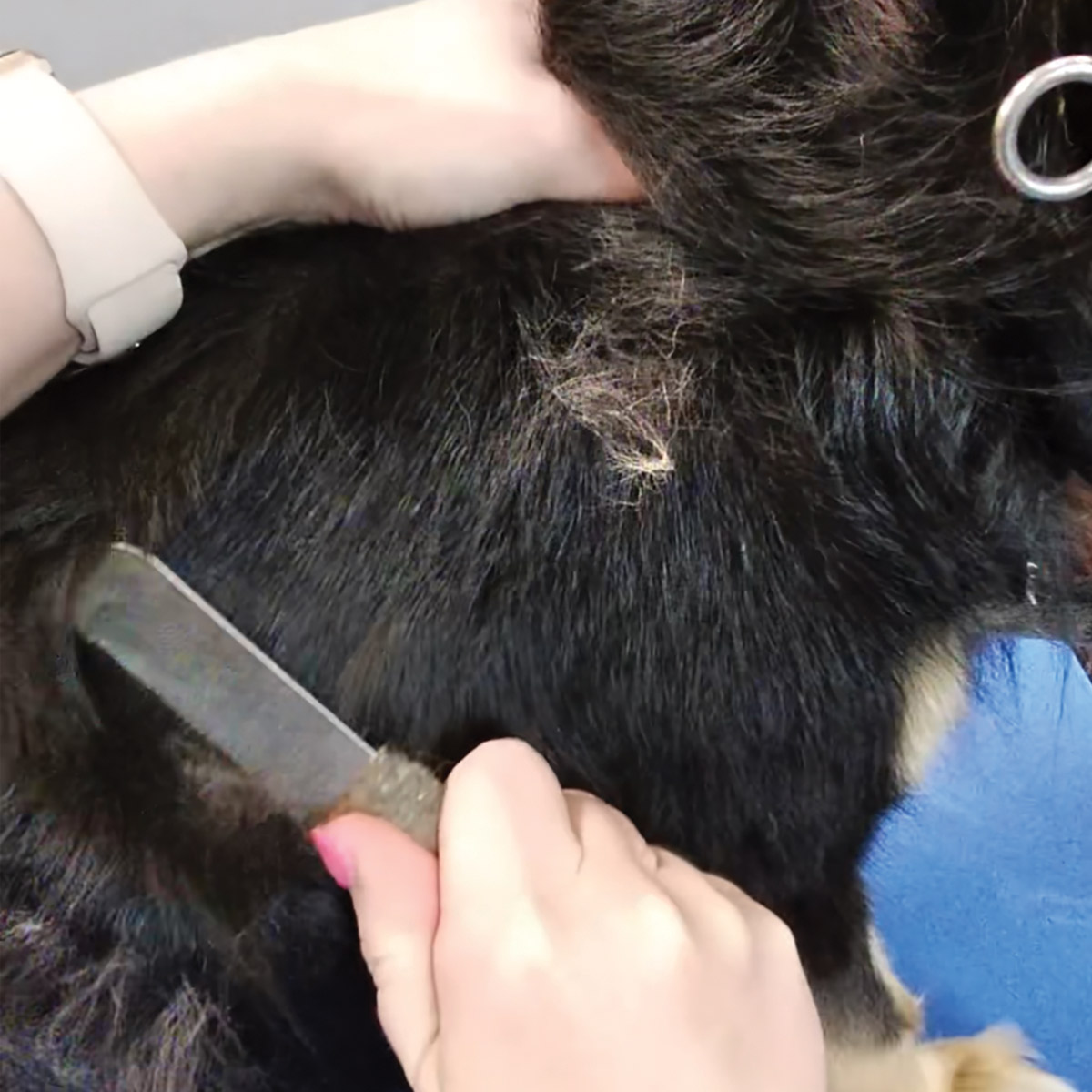















These types of dogs can be so satisfying to work with because they look as if their hair just grows that way! But as groomers, we know that there is a lot more that goes into it. By adding these extra steps, we can take this service from “just a bath and brush” to a beautiful, natural full groom!

by Anjie Coates
Photo by Anjie Coates
 aly is a wonderfully sweet hound with degenerative neuropathy. She’s only a bit over a year old, but her body shows the signs of the disease in many ways. She’s finally gained some weight and is currently doing OK.
aly is a wonderfully sweet hound with degenerative neuropathy. She’s only a bit over a year old, but her body shows the signs of the disease in many ways. She’s finally gained some weight and is currently doing OK.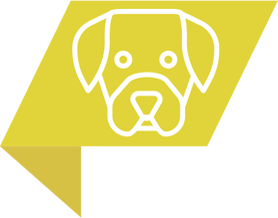 Caly: “Spa day! Spa day! I’m having a spa day!”
Caly: “Spa day! Spa day! I’m having a spa day!” “Yes, you are!” I say as I laugh and scoop her into my arms.
“Yes, you are!” I say as I laugh and scoop her into my arms. I kiss her soft face and carry her into the back as she wags wildly and smashes her face into mine for more kisses.
I kiss her soft face and carry her into the back as she wags wildly and smashes her face into mine for more kisses. Caly: “Am I getting the special shampoo today?
Caly: “Am I getting the special shampoo today? “Yep. Last time it made you even softer, if that’s possible,” I reply.
“Yep. Last time it made you even softer, if that’s possible,” I reply. Caly: “Mom thought so too. I got so many hugs and smooches. I love hugs and smooches.”
Caly: “Mom thought so too. I got so many hugs and smooches. I love hugs and smooches.” “Really? You don’t say,” I quip.
“Really? You don’t say,” I quip. Caly: “You’re silly.”
Caly: “You’re silly.” I froth up her shampoo and scoop her into the tub.
I froth up her shampoo and scoop her into the tub. Caly’s tail beats a rhythmic staccato against the side of the tub.
Caly’s tail beats a rhythmic staccato against the side of the tub. “You’ve gained some weight. Looks like you’ve got a teeny belly!” I say.
“You’ve gained some weight. Looks like you’ve got a teeny belly!” I say. Caly: “Yeah. I feel good.
Caly: “Yeah. I feel good. “I’m glad. It’ll make brushing you easier too; smoother surface,” I add.
“I’m glad. It’ll make brushing you easier too; smoother surface,” I add. Caly grins and revels in her bath and conditioning.
Caly grins and revels in her bath and conditioning.
 I towel her off and apply oils, then wrap her in a warm towel.
I towel her off and apply oils, then wrap her in a warm towel. Caly: “My turn! It’s my turn!”
Caly: “My turn! It’s my turn!” “Need a minute, babe. I just have to get this cleaned up and then it’s your turn on the table,” I assure her.
“Need a minute, babe. I just have to get this cleaned up and then it’s your turn on the table,” I assure her. I finish disinfecting everything and head to her crate to get her. We get to the table where she throws her front half up while I scoop her out of the air to ensure she doesn’t fall.
I finish disinfecting everything and head to her crate to get her. We get to the table where she throws her front half up while I scoop her out of the air to ensure she doesn’t fall. “You are feeling good. Bit of a wild woman today,” I say.
“You are feeling good. Bit of a wild woman today,” I say. Caly grins and leans against me in relaxation as I finish drying her.
Caly grins and leans against me in relaxation as I finish drying her. “OK, let’s do nails and get a few pounds of your fur brushed out, shall we?” I propose.
“OK, let’s do nails and get a few pounds of your fur brushed out, shall we?” I propose. Caly: “OK!”
Caly: “OK!” As I’m doing her nails, Caly starts to tip over. I ask my assistant for a hand, and she helps to right her on the table.
As I’m doing her nails, Caly starts to tip over. I ask my assistant for a hand, and she helps to right her on the table. “Relax your feet, babe. You tip over when you get excited,” I tell her.
“Relax your feet, babe. You tip over when you get excited,” I tell her. Caly: “I’m happy!”
Caly: “I’m happy!” “I can tell! OK, let’s see about that brushing now.” I say.
“I can tell! OK, let’s see about that brushing now.” I say. Caly wags and nudges as my assistant brushes her head and I brush her body. We each stand to one side of her so she can’t fall.
Caly wags and nudges as my assistant brushes her head and I brush her body. We each stand to one side of her so she can’t fall. OK. Ears and you’re done!” I say.
OK. Ears and you’re done!” I say. Caly: “Already?”
Caly: “Already?”
 “We still have the picture,” I remind her.
“We still have the picture,” I remind her. Caly: “Oh, good!”
Caly: “Oh, good!” I scoop her up and carry her into the picture room and put her on the platform.
I scoop her up and carry her into the picture room and put her on the platform. “What do you want to be?” I ask as I offer her a ladybug and a bee costume.
“What do you want to be?” I ask as I offer her a ladybug and a bee costume. Caly: “This one!”
Caly: “This one!” She chooses the bee and dives her head into the tutu.
She chooses the bee and dives her head into the tutu. “It’s actually easier if we start from the other…nevermind.” I say as I slide the tutu over her front feet and down her waist.
“It’s actually easier if we start from the other…nevermind.” I say as I slide the tutu over her front feet and down her waist. Her tail never stops wagging and the tutu swishes from side to side.
Her tail never stops wagging and the tutu swishes from side to side. “What a beautiful girl! Do you want a treat today?” I ask.
“What a beautiful girl! Do you want a treat today?” I ask. Caly: “Nope!” as she leaps off the table into me.
Caly: “Nope!” as she leaps off the table into me. I barely catch her, then right her in my arms.
I barely catch her, then right her in my arms. Caly: “I want smooches!”
Caly: “I want smooches!” And I reply,
And I reply,



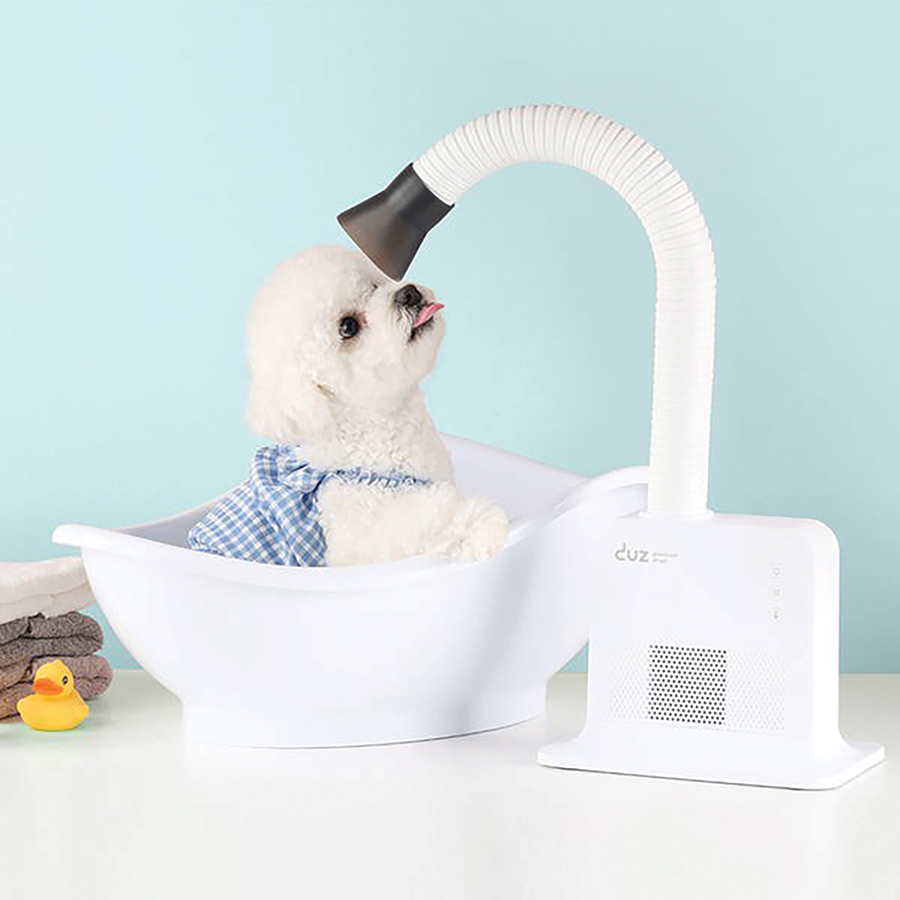
DUZ V2PRO UPGRADED PROFESSIONAL HANDS-FREE PET DRYER
Call
(717) 691-3388
ext 224 to place a Classified.
Rates: 25 words or less $50.00
$2.00 each
Classified ads must be prepaid.
Call for issue deadlines.
Agency discounts do not apply.



